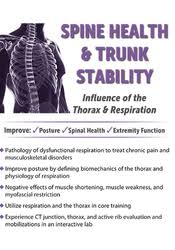🎁 Exclusive Discount Just for You!
Today only: Get 30% OFF this course. Use code MYDEAL30 at checkout. Don’t miss out!
The center of trunk rotation is the thorax, which is an essential component of spinal function. It is responsible for shifting weight from the lower extremities (LE), to the upper extremities, and through the regions of spine.
Debra Dent – Spine Health, Trunk Stability

Clinical Observations & Implications
- The evidence-Clinical observation and based practice
- Patients and their families: Clinical implications
- Chronic low back, SI joint and SI pain
- Older people may have trunk weakness and scoliosis.
- Chronic hip pain and lateral knee pain
- Chronic headaches and cervical pain
- Shoulder impingement
- Thoracic outlet syndrome
- Fibromyalgia
- Balance and gait deviations
- Sport performance
- Case histories — Could this be your patient?
- Chronic pain
- Marathon runner/triathlete
- Chronic neck and low back pain
Anatomy
- Biomechanics/respiratory anatomy/thoracic anatomy
- Thoracic anatomy
- Anatomy of the rib
- Thoracic biomechanics
- CT junction biomechanics
- TL junction biomechanics
- Trunk Musculature
- Core-inner group
- Outer group
- Posterior oblique
- Deep longitudinal
- Anterior
- Lateral
- Psoas/hamstring Integration
- Scalenes, SCM, C spine muscles
- Inspirational muscles
- Expiration muscles
- Trunk Musculature
- Mechanisms of respiration
- Normal breathing-Mechanisms
- Physiology of respiration
- Lung volumes
- Lung perfusion
- Hyperventilation/alkalosis
- Fascial integration
- Thorocolumbar fascia
- Lateral femoral fascia/IT band
- Abdominal fascia
- Biomechanical relationships between Cervical/UE, and Pelvis/LE
Neuromuscular Control
- The central nervous system controls muscle tone and movement
- Sympathetic or parasympathetic responses
Demonstration in the Lab
- Evaluation and treatment techniques
- Evaluation of posture in relation to respiratory function, UE and pelvis function
- Mechanisms of respiration
- Diaphragmatic, lateral, costal, Sternal, and apical breathing
- Position of the Diaphragm
- Seated arm raise
- Rotation of the trunk seated
- Standing torque
- Testing for muscle function
- Supine active SL
- Prone active SLR, and active arm raise
- Multifidus, TA, and pelvic floor function
- Posterior oblique system
- Anterior oblique system
- System of laterals
- Mobility testing and active mobilizations for rib position and mobility
- Longening and length testing
- Training program for core facilitation entry
- Case history evaluations, treatments and outcomes
Theory & Evidence-Based Practice
- Poor breathing patterns
- More-Inflation
- Upper chest breathing
- Effects of diaphragm and trunk rotation on the lumbar spine/hips/LE/C spine and UE- trunkrotation or lack thereof
- Improper load transference and posture
- Trunk stability and the diaphragm/core/incontinence
- Hypertonicity/over activation
- Poor control of chronic low back and SI joint pain
- Older people may have trunk weakness and scoliosis.
- Chronic hip pain and lateral knee pain
- Chronic headaches and cervical pain
- Issues relating to shoulder impingement
- Thoracic outlet syndrome
- Fibromyalgia
- Balance and gait deviations
- Sport performance
- Respiratory alkalosis/hyperventilation and the consequences
- Chronic fatigue, fibromyalgia and chronic pain
Would you like to be contacted? Debra Dent – Spine Health, Trunk Stability ?
Description:
An evidence-Based Practice Solution for Spinal Health, Stabilization, & Posture
The center of trunk rotation is the thorax, which is an essential component of spinal function. It is responsible for shifting weight from the lower extremities (LE), to the upper extremities, and through the regions of spine. It provides a solid base for muscles and fascial connections to the cervical/ UE, lumbo/pelvic/LE and lumbo/pelvic/LE. The diaphragm’s dual functions are in posture and respiration. It has strong muscular and neurological connections to the pelvic floor, lumbar spine, abdominals and pelvic floor.-Abdominal pressure is vital for spinal stability as well as functional posture.
Dysfunction of trunk muscles, weakness and muscular inhibition, dysfunction of the respiratory complex and trunk muscular imbalances all have significant consequences on posture, trunk stability, motion, chronic pain, movement and upper and/or lower extremity function.
This recording enhances your knowledge about spinal health, stabilization and posture. Ms. Dent This video demonstrates how the vital integration between the diaphragm and thorax is possible in a functional spinal program that lasts a long time.-term, successful patient outcomes. Participants will learn how normal breathing patterns can be regained for spine health, and overall patient wellbeing.-being. You can practice these techniques in an interactive and hands-on environment.-You will leave the lab with confidence and ready to put them into action.
Course Features
- Lectures 0
- Quizzes 0
- Duration Lifetime access
- Skill level All levels
- Language English
- Students 0
- Assessments Yes
